Recent Advances in the Analysis of Vitamin D and Its Metabolites in Food Matrices
Abstract
1. Introduction
2. Recent Applications of Sample Preparation
2.1. Conventional Extraction Techniques
2.2. Solid-Phase Extraction
2.3. Preparative Chromatographic Techniques
2.4. Miniaturized Techniques
3. Recent Applications of Chromatographic Techniques
3.1. Liquid Chromatography Applications
3.2. Gas Chromatography
3.3. Supercritical Fluid Chromatography
4. Conclusions and Future Remarks
Author Contributions
Funding
Acknowledgments
Conflicts of Interest
References
- Kasalová, E.; Aufartová, J.; Kujovská Krčmová, L.; Solichová, D.; Solich, P. Recent trends in the analysis of vitamin D and its metabolites in milk—A review. Food Chem. 2015, 171, 177–190. [Google Scholar] [CrossRef]
- Kühn, J.; Schutkowski, A.; Hirche, F.; Baur, A.C.; Mielenz, N.; Stangl, G.I. Non-linear increase of vitamin D content in eggs from chicks treated with increasing exposure times of ultraviolet light. J. Steroid Biochem. Mol. Biol. 2015, 148, 7–13. [Google Scholar] [CrossRef] [PubMed]
- Yin, S.; Yang, Y.; Wu, L.; Li, Y.; Sun, C. Recent advances in sample preparation and analysis methods for vitamin D and its analogues in different matrices. TrAC-Trend. Anal. Chem. 2019, 110, 204–220. [Google Scholar] [CrossRef]
- Oberson, J.M.; Bénet, S.; Redeuil, K.; Campos-Giménez, E. Quantitative analysis of vitamin D and its main metabolites in human milk by supercritical fluid chromatography coupled to tandem mass spectrometry. Anal. Bioanal. Chem. 2020, 412, 365–375. [Google Scholar] [CrossRef] [PubMed]
- Patrick, R.P.; Ames, B.N. Vitamin D hormone regulates serotonin synthesis. Part 1: Relevance for autism. FASEB J. 2014, 24, 2398–2413. [Google Scholar] [CrossRef] [PubMed]
- Patrick, R.P.; Ames, B.N. Vitamin D and the omega-3 fatty acids control serotonin synthesis and action, part 2: Relevance for ADHD, bipolar disorder, schizophrenia, and impulsive behavior. FASEB J. 2015, 29, 2207–2222. [Google Scholar] [CrossRef] [PubMed]
- Wittig, M.; Krings, U.; Berger, R.G. Single-run analysis of vitamin D photoproducts in oyster mushroom (Pleurotus ostreatus) after UV-B treatment. J. Food Comp. Anal. 2013, 31, 266–274. [Google Scholar] [CrossRef]
- Bartoluccia, G.; Giocaliere, E.; Boscaro, F.; Vannacci, A.; Gallo, E.; Pieraccini, G.; Moneti, G. Vitamin D3 quantification in a cod liver oil-based supplement. J. Pharm. Biomed. Anal. 2011, 55, 64–70. [Google Scholar] [CrossRef]
- Hughes, L.J.; Black, L.J.; Sherriff, J.L.; Dunlop, E.; Strobel, N.; Lucas, R.M.; Bornman, J.F. Vitamin D content of Australian native food plants and australian-grown edible seaweed. Nutrients 2018, 10, 876. [Google Scholar] [CrossRef]
- Bilodeau, L.; Dufresne, G.; Deeks, J.; Clément, G.; Bertrand, J.; Turcotte, S.; Robichaud, A.; Beraldin, F.; Fouquet, A. Determination of vitamin D3 and 25-hydroxyvitamin D3 in foodstuffs by HPLC UV-DAD and LC–MS/MS. J. Food Comp. Anal. 2011, 24, 441–448. [Google Scholar] [CrossRef]
- Lips, P.; Cashman, K.D.; Lamberg-Allardt, C.; Bischoff-Ferrari, H.A.; Obermayer-Pietsch, B.; Bianchi, M.L.; Stepan, J.; El-Hajj Fuleihan, G.; Bouillon, R. Current vitamin D status in European and Middle East countries and strategies to prevent vitamin D deficiency: A position statement of the European calcified tissue society. Eur. J. Endocrinol. 2019, 180, P23–P54. [Google Scholar] [CrossRef] [PubMed]
- FDA. Food labelling: Revision of the nutritional and supplement facts labels. Fed. Regist. 2016, 81, 33741. [Google Scholar]
- Codex Alimentaroux. Advisory Lists of Nutrient Compounds for Use in Foods for Special Dietary Uses Intended for Infants and Young Children, CAC/GL 10/1979, last amended 2008.
- Kiely, M.; Cashman, K.D. The ODIN project: Development of food-based approaches for prevention of vitamin D deficiency throughout life. Nutr. Bull. 2015, 40, 235–246. [Google Scholar] [CrossRef]
- International Standard ISO 14892|IDF 177. Dried Skimmed Milk –Determination of Vitamin D Content Using High-Performance Liquid Chromatography; ISO: Geneva, Switzerland, 2002. [Google Scholar]
- European Standard EN. 12821 Foodstuffs—Determination of Vitamin D by High Performance Liquid Chromatography—Measurement of Cholecalciferol (D3) or Ergocalciferol (D2). 2009. [Google Scholar]
- AOAC Official Method 2011.13. Vitamin D2 and D3 in Infant formula and Adult Nutritionals. LC–MS/MS, First Action 2011; AOAC International: Gaithersburg, MD, USA, 2012. [Google Scholar]
- AOAC Official Method 2016.05. Analysis of Vitamin D2 and Vitamin D3 in Fortified Milk Powders and Infant and Nutritional Formulas by Liquid Chromatography–Tandem Mass Spectrometry: Single-Laboratory Validation, First Action 2016; AOAC International: Gaithersburg, MD, USA, 2016. [Google Scholar]
- AOAC Official Method 992.26. Vitamin D3 (Cholecalciferol) in Ready-To-Feed Milk-Based Infant Formula. First Action 1992; AOAC International: Gaithersburg, MD, USA, 2006. [Google Scholar]
- AOAC Official Method 995.05. Vitamin D in Infant Formula and Enteral Products. Liquid Chromatography. First Action 1995; AOAC International: Gaithersburg, MD, USA, 2000. [Google Scholar]
- AOAC Official Method 2002.05. Determination of Cholecalciferol (Vitamin D3) in Selected Food. Liquid Chromatography. First Action 2002; AOAC International: Gaithersburg, MD, USA, 2003. [Google Scholar]
- David, E.; Eleazu, C.; Igweibor, N.; Ugwu, C.; Enwefa, G.; Nwigboji, N. Comparative study on the nutrients, heavy metals and pesticide composition of some locally produced and marketed rice varieties in Nigeria. Food Chem. 2019, 278, 617–624. [Google Scholar] [CrossRef] [PubMed]
- Oberson, J.-M.; Campos-Giménez, E.; Rivière, J.; Martin, F. Application of supercritical fluid chromatography coupled to mass spectrometry to the determination of fat-soluble vitamins in selected food products. J. Chromatogr. B 2018, 1086, 118–129. [Google Scholar] [CrossRef]
- Lipkie, T.E.; Ferruzzi, M.G.; Weaver, C.M. Low bioaccessibility of vitamin D2 from yeast fortified bread compared to crystalline D2 bread and D3 from fluid milks. Food Funct. 2016, 7, 4589–4596. [Google Scholar] [CrossRef]
- Mohanty, B.P.; Sankar, T.V.; Ganguly, S.; Mahanty, A.; Anandan, R.; Chakraborty, K.; Paul, B.N.; Sarma, D.; Dayal, J.S.; Mathew, S.; et al. Micronutrient composition of 35 food fishes from India and their significance in human nutrition. Biol. Trace Elem. Res. 2016, 174, 448–458. [Google Scholar] [CrossRef]
- Gill, B.D.; Abernethy, G.A.; Green, R.J.; Indyk, H.E. Analysis of vitamin D2 and vitamin D3 in fortified milk powders and infant and nutritional formulas by liquid chromatography–tandem mass spectrometry: Single- laboratory validation, First Action 2016.05. J. AOAC Int. 2016, 99, 1321–1330. [Google Scholar] [CrossRef][Green Version]
- Byrdwell, W.C. Quadruple parallel mass spectrometry for analysis of vitamin D and triacylglycerols in a dietary supplement. J. Chromatogr. A 2013, 1320, 48–65. [Google Scholar] [CrossRef]
- Barba, F.J.; Esteve, M.J.; Frígola, A. Determination of vitamins E (α-, γ- and δ-tocopherol) and D (cholecalciferol and ergocalciferol) by liquid chromatography in milk, fruit juice and vegetable beverage. Eur. Food Res. Technol. 2011, 232, 829–836. [Google Scholar] [CrossRef]
- Kwak, B.-M.; Jeong, I.-S.; Lee, M.-S.; Ahn, J.-H.; Park, J.-S. Rapid determination of vitamin D3 in milk-based infant formulas by liquid chromatography-tandem mass spectrometry. Food Chem. 2014, 165, 569–574. [Google Scholar] [CrossRef]
- Rathi, D.-N.; Noh, M.F.M.; Abd Rashed, A.; Dasuki, I. Simultaneous analysis of vitamin D and K in processed food products via ultra high- performance liquid chromatography (UHPLC). J. Food Meas. Charact. 2019, 13, 1947–1957. [Google Scholar] [CrossRef]
- Płonka, J.; Toczek, A.; Tomczyk, V. Multivitamin analysis of fruits, fruit–vegetable juices, and diet supplements. Food Anal. Methods 2012, 5, 1167–1176. [Google Scholar] [CrossRef]
- Kühna, J.; Schröter, A.; Hartmann, B.M.; Stangla, G.I. Cocoa and chocolate are sources of vitamin D2. Food Chem. 2018, 269, 318–320. [Google Scholar] [CrossRef] [PubMed]
- Nestola, M.; Thellmann, A. Determination of vitamins D2 and D3 in selected food matrices by online high-performance liquid chromatography–gas chromatography–mass spectrometry (HPLC-GC-MS). Anal. Bioanal. Chem. 2015, 407, 297–308. [Google Scholar] [CrossRef] [PubMed]
- Byrdwell, W.C.; Horst, R.L.; Phillips, K.M.; Holden, J.M.; Patterson, K.Y.; Harnly, J.M.; Exler, J. Vitamin D levels in fish and shellfish determined by liquid chromatography with ultraviolet detection and mass spectrometry. J. Food Comp. Anal. 2013, 30, 109–119. [Google Scholar] [CrossRef]
- Byrdwell, W.C.; Exler, J.; Gebhardt, S.E.; Harnly, J.M.; Holden, J.M.; Horst, R.L.; Patterson, K.Y.; Phillips, K.M.; Wolf, W.R. Liquid chromatography with ultraviolet and dual parallel mass spectrometric detection for analysis of vitamin D in retail fortified orange juice. J. Food Comp. Anal. 2011, 24, 299–306. [Google Scholar] [CrossRef]
- Kamankesh, M.; Mohammadi, A.; Mollahosseini, A.; Jazaeri, S.; Shahdoostkhany, M. Vitamin D3: Preconcentration and determination in cereal samples using ultrasonic-assisted extraction and microextraction method. Cereal Chem. 2017, 94, 532–538. [Google Scholar] [CrossRef]
- Jiao, Z.; Zhang, Y.; Fan, H. Ultrasonic-microwave method in preparation of polypyrrole-coatedmagnetic particles for vitamin D extraction in milk. J. Chromatogr. A 2016, 1457, 7–13. [Google Scholar] [CrossRef]
- Viñas, P.; Bravo-Bravo, M.; López-García, I.; Hernández-Córdoba, M. Dispersive liquid–liquid microextraction for the determination of vitamins D and K in foods by liquid chromatography with diode-array and atmospheric pressure chemical ionization-mass spectrometry detection. Talanta 2013, 115, 806–813. [Google Scholar] [CrossRef]
- Hu, C.; Jia, L.; Liu, Q.; Zhang, S. Development of magnetic octadecylsilane particles as solid-phase extraction adsorbent for the determination of fat-soluble vitamins in fruit juice-milk beverage by capillary liquid chromatography A. J. Sep. Sci. 2010, 33, 2145–2152. [Google Scholar] [CrossRef] [PubMed]
- Gomes, F.P.; Shaw, P.N.; Whitfield, K.; Hewavitharana, A.K. Simultaneous quantitative analysis of eight vitamin D analogues in milk using liquid chromatography tandem mass spectrometry. Anal. Chim. Acta 2015, 891, 211–222. [Google Scholar] [CrossRef] [PubMed]
- Schadt, H.S.; Gössl, R.; Seibel, N.; Aebischer, C.-P. Quantification of vitamin D3 in feed, food, and pharmaceuticals using high-performance liquid chromatography/tandem mass spectrometry. J. AOAC Int. 2012, 95, 1487–1494. [Google Scholar] [CrossRef] [PubMed]
- Burild, A.; Frandsen, H.L.; Poulsen, M.; Jakobsen, J. Quantification of physiological levels of vitamin D3 and 25-hydroxyvitamin D3 in porcine fat and liver in subgram sample sizes. J. Sep. Sci. 2014, 37, 2659–2663. [Google Scholar] [CrossRef]
- Byrdwell, W.C. “Dilute-and-shoot” triple parallel mass spectrometry method for analysis of vitamin D and triacylglycerols in dietary supplements. Anal. Bioanal. Chem. 2011, 401, 3317–3334. [Google Scholar] [CrossRef]
- Prabu, S.L.; Suriya Prakash, T.N.K.; Thirumurugan, R. Cleaning validation and its regulatory aspects in the pharmaceutical industry. In Developments in Surface Contamination and Cleaning, 1st ed.; Kohli, R., Mittal, K.L., Eds.; Elsevier Inc.: Oxford, UK, 2015; Volume 7, pp. 129–186. [Google Scholar]
- Qian, H.; Sheng, M. Simultaneous determination of fat-soluble vitamins A, D and E and pro-vitamin D in animal feeds by one-step extraction and high-performance liquid chromatography analysis. J. Chromatogr. A 1998, 825, 127–133. [Google Scholar] [CrossRef]
- Kabir, A.; Locatelli, M.; Ulusoy, H.I. Recent Trends in microextraction techniques employed in analytical and bioanalytical sample preparation. Separations 2017, 4, 36. [Google Scholar] [CrossRef]
- Socas-Rodríguez, B.; González-Sálamo, J.; Hernández-Borges, J.; Rodríguez-Delgado, M.Á. Recent applications of nanomaterials in food safety. TrAC-Trend. Anal. Chem. 2017, 96, 172–200. [Google Scholar] [CrossRef]
- Fanali, C.; D’Orazio, G.; Fanali, S.; Gentili, A. Advanced analytical techniques for fat-soluble vitamin analysis. TrAC-Trend. Anal. Chem. 2017, 87, 82–97. [Google Scholar] [CrossRef]
- Taguri, K.; Fukusaki, E.; Bamba, T. Simultaneous analysis for water- and fat-soluble vitamins by a novel single chromatography technique unifying supercritical fluid chromatography and liquid chromatography. J. Chromatogr. A 2014, 1362, 270–277. [Google Scholar]
- Tarafder, A. Metamorphosos of supercritical fluid chromatography to SFC: An overview. TrAC-Trend. Anal. Chem. 2016, 81, 3–10. [Google Scholar] [CrossRef]
- Losacco, G.L.; Veuthey, J.-L.; Guillarme, D. Supercritical fluid chromatography e Mass spectrometry: Recent evolution and current trends. TrAC-Trend. Anal. Chem. 2019, 118, 731–738. [Google Scholar] [CrossRef]
- Nováková, L.; Grand-Guillaume Perrenoud, A.; Francois, I.; West, C.; Leseiller, E.; Guillerme, D. Modern analytical supercritical fluid chromatography using columns packed with sub-2 μm particles: A tutorial. Anal. Chim. Acta 2014, 824, 18–25. [Google Scholar] [CrossRef] [PubMed]
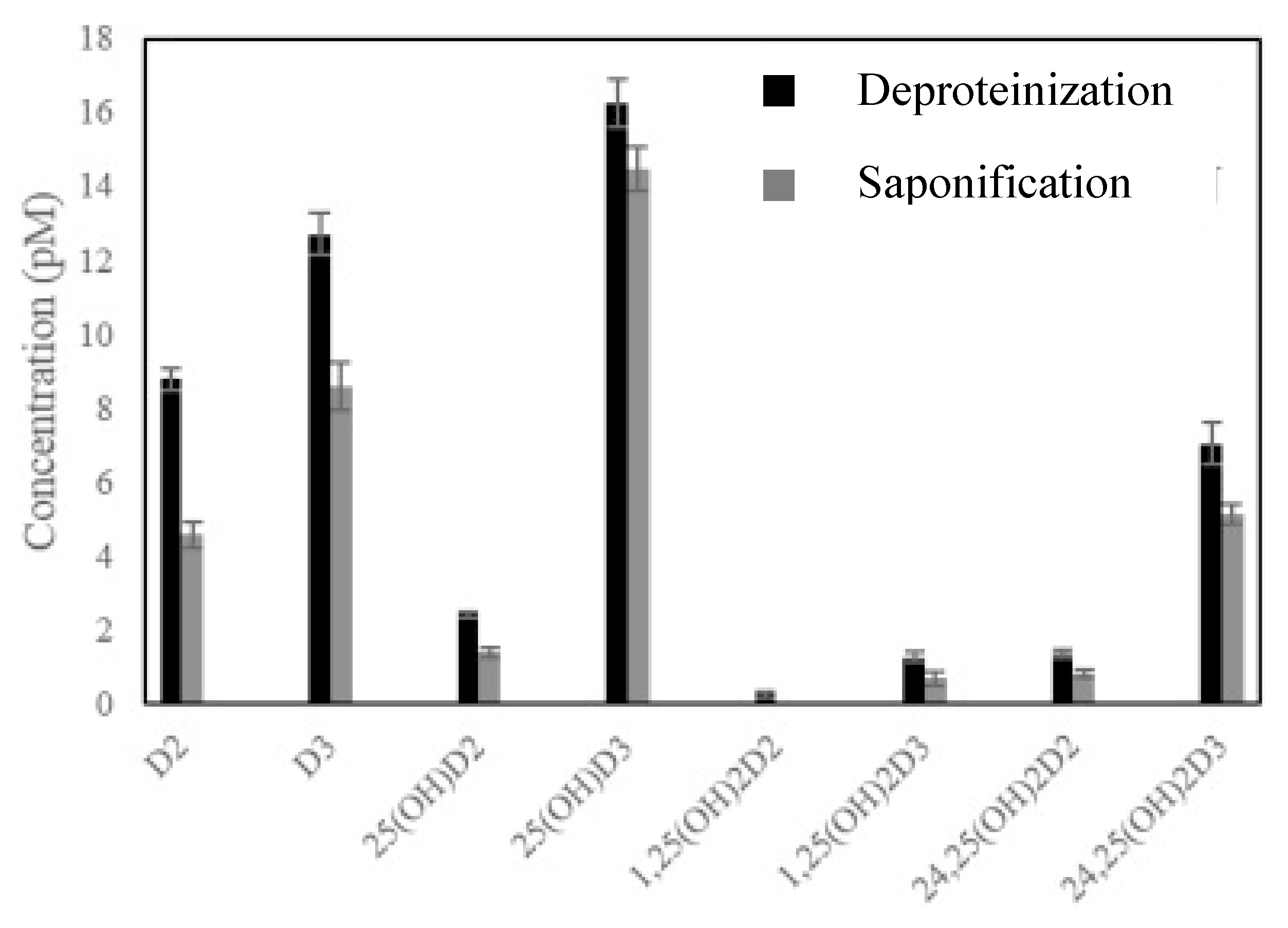
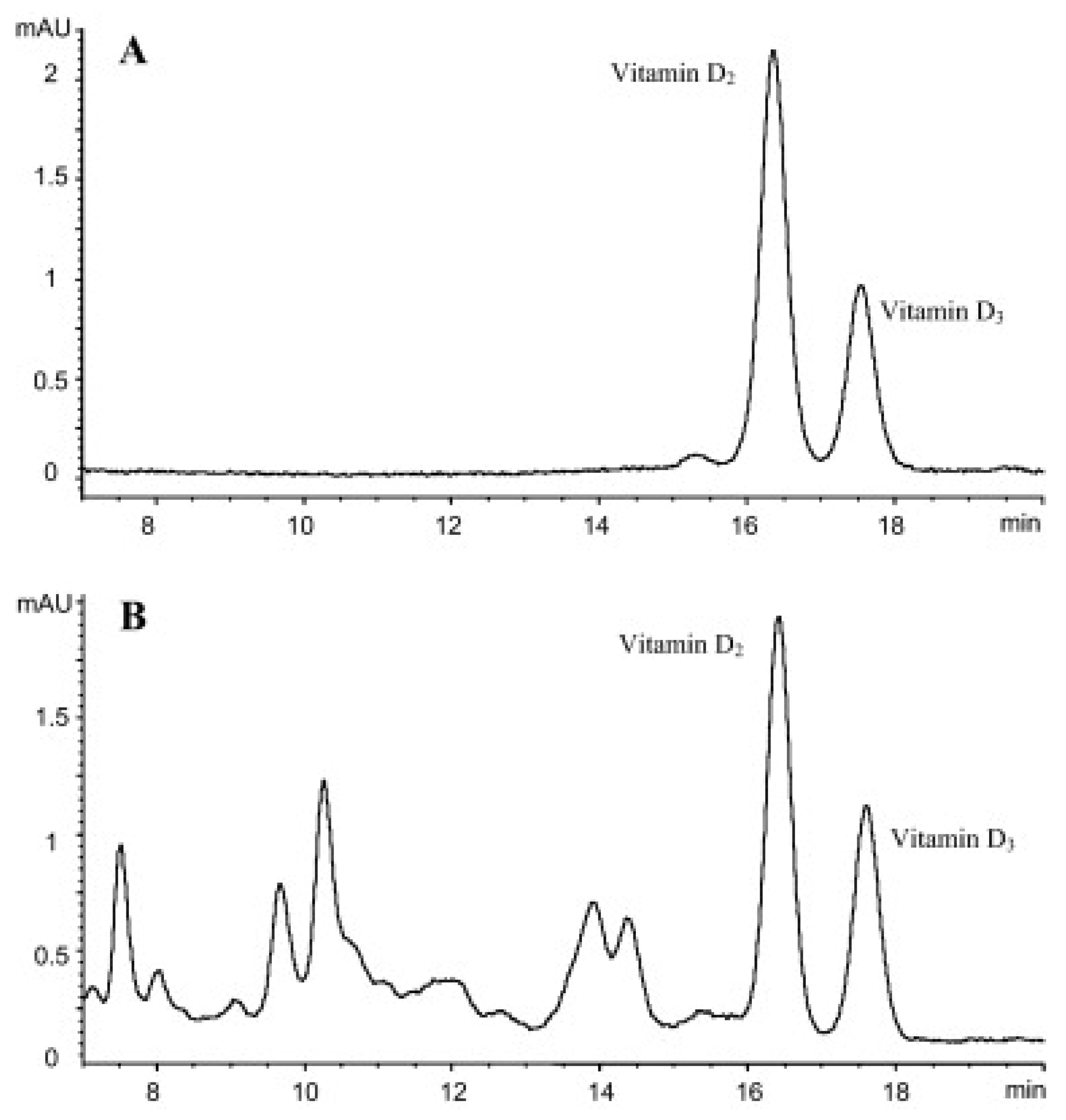

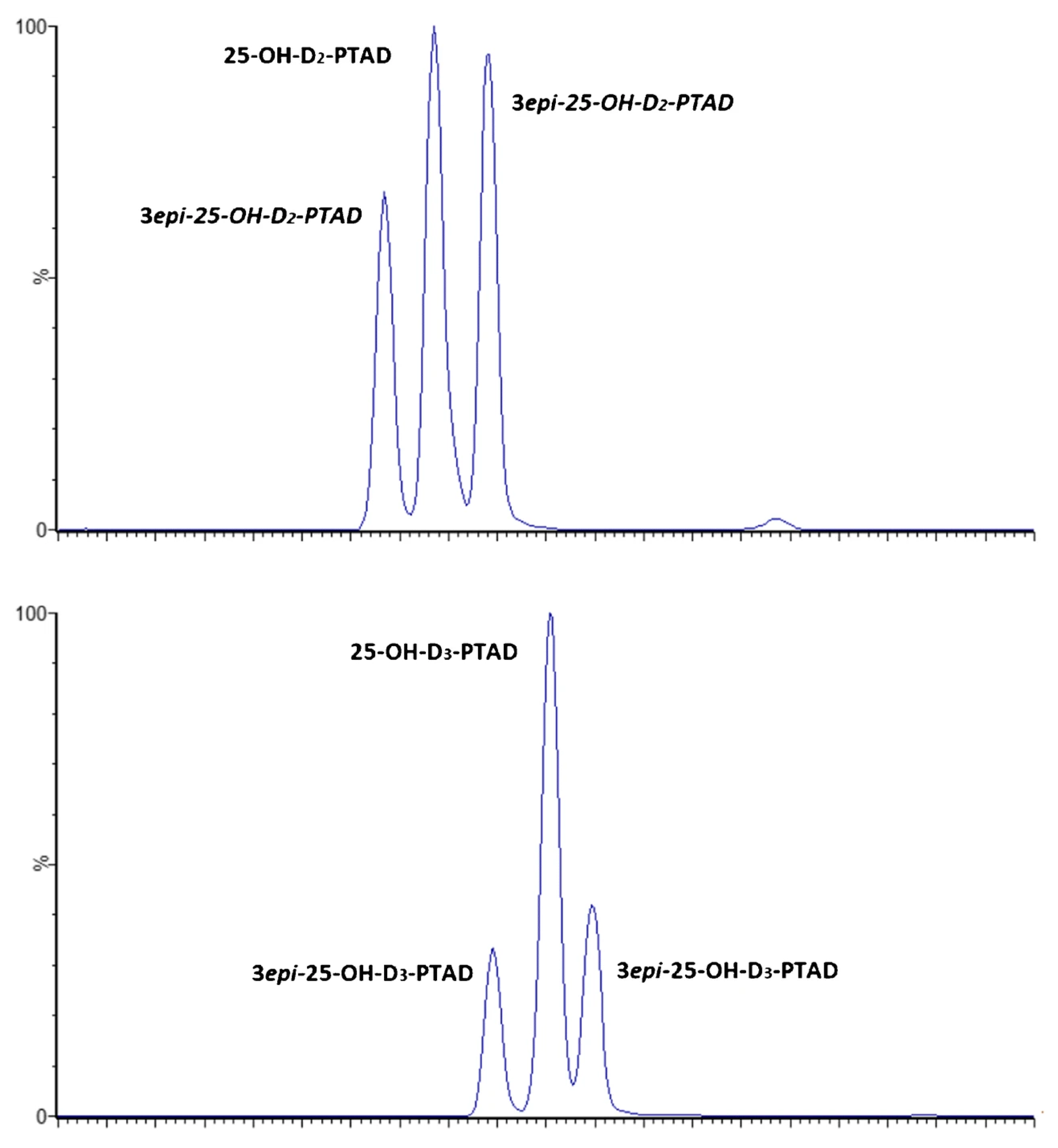
| Name | Structure | Molecular Formula | Molecular Weight (g/mol) | Name | Structure | Molecular Formula | Molecular Weight (g/mol) |
|---|---|---|---|---|---|---|---|
| D3 | 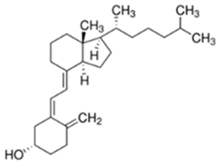 | C27H44O | 384.65 | 1OH-D2 | 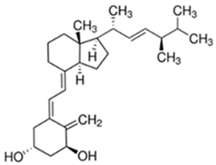 | C28H44O2 | 412.65 |
| D2 | 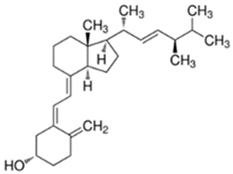 | C28H44O | 396.66 | 24,25-(OH)2D3 | 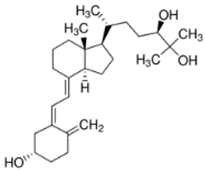 | C27H44O3 | 416.64 |
| 25-OHD2 | 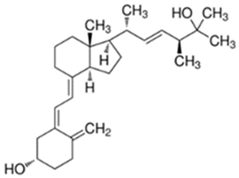 | C28H44O2 | 412.65 | 1,25-(OH)2D2 | 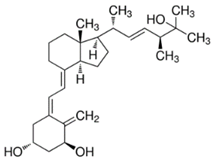 | C28H44O3 | 428.70 |
| 25-OHD3 | 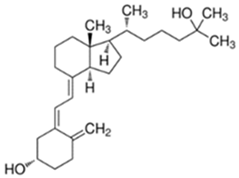 | C27H44O2 | 400.64 | 1,25-(OH)2D3 | 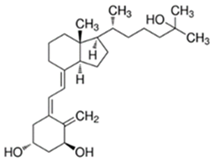 | C27H44O3 | 416.64 |
| 1-OHD3 | 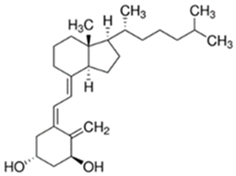 | C27H44O2 | 400.64 |
| Analytes | Matrix (Amount) | Sample Pre-Treatment | Determination Technique | Recovery % | LOD | Comments | Reference |
|---|---|---|---|---|---|---|---|
| D2, D3, 25-OHD2, 3-epi-25-OHD2, 25-OHD3, 3- epi-25-OHD3 | Commercial breast milk (1 mL) | Deproteinization (40 °C, 1 h, EtOH (1 mL)); LLE 2 X (hexane/EtOAc (9/1, v/v) (2.5 mL)) | UHPSFC-(QqQ)-MS/MS | 70–107 | 0.02 μg/L a) | -APCI (+) was used as ionization source. -NH4HCOO in MeOH was used as make-up solvent. -Different columns were evaluated. -Derivatization was carried out using PTAD. -Deuterated compounds were used as ISs. -Comparison between saponification and deproteinization. -SRM was used for method validation. -SFC conditions: fluoro-phenyl column, mobile phase (MeOH/NH4HCOO/H2O/CO2), 45 °C. | [4] |
| D3 | Rice (1 g) | SLE (hexane (4 mL), 5 min under N2) | HPLC-UV | - | - | -Vitamin A, E and amino acids and pesticides were also evaluated. -LC conditions: C18 column, mobile phase (ACN/H2O), 30 °C. -Occurrence: 13.8–28.6 mg/kg. | [22] |
| D2, D3 | Infant formula, cereals, adult nutritionals, mixed meals (2 g) | Hydrolysis (α-amylase (50 mg): 45 °C, 30 min, papain solution (5 mL)); LLE (acidified MeOH (20 mL), BHT in isooctane (10 mL)) | UHPSFC-(QqQ)-MS/MS | 90–110 | 40 pg a) | -APCI (+) was used as ionization source. -NH4HCOO in MeOH was used as make-up solvent. -SRM was used for method validation. -Vitamin K, A and D were also evaluated. -Derivatization was carried out using PTAD. -Isotopically labelled compounds were used as surrogate ISs. -SFC conditions: 1-AA column, mobile phase (MeOH/NH4HCOO/H2O/CO2), 45 °C. | [23] |
| D2, D3 | Fortified bread, bovine milk, infant formula (4 g) | Milk and infant formulas: VA-LLE (MeOH/H2O/isooctane (6.25/1.25/2.50, v/v/v), 2 min). Bread: homogeneization (EDTA (2 mL), ascorbic acid (100 mg), vortex), saponification (KOH in water, 60 °C, 30 min), LLE (MeOH/isooctane, (2/1, v/v), (30 mL)) | HPLC-(QqQ)-MS/MS | - | - | -ESI (+) was used as ionization source. -Deuterated D3 was used as surrogate IS. -Comparison of D2 and D3 supplement efficiency. -LC conditions: C18 column, mobile phase (MeOH/H2O/NH4HCOO), 40 °C. | [24] |
| D3 | Finfish, shellfish (30 g) | Folch method (CHCl3/MeOH, (2/1, v/v) (450 mL)); saponification (KOH in MeOH, 30 min, refluxing): LLE (petroleum ether, (50 mL)) | HPLC-UV | - | - | -Mineral and other fat-soluble vitamins were also evaluated. -LC conditions: C18 column, mobile phase (MeOH/ACN), -. -Occurrence: 7.72–23.28 μg/kg. | [25] |
| D2, D3 | Milk powder, infant formulas, nutritional formulas (1.8–21.0 g or 10 mL) | Saponification (KOH, pyrogallol, EtOH, 1 h, 70 °C); LLE (isooctane (10 mL)); washing (H2O) | UHPLC-(QqQ)-MS/MS | 96–101 | 1.2–1.6 µg/kg | -ESI (+) was used as ionization source. -Derivatization was carried out using PTAD. -AOAC Official Method 2016.05. -Deuterated standards were used as ISs. -LC conditions: C18 column, mobile phase (MeOH/H2O/FA), 40 °C. | [26] |
| D3, D2, 25-OHD2, 25-OHD2, 24,25-(OH)2D2, 24,25-(OH)2D3, 1,25-(OH)2D2, 1,25-(OH)2D3 | Human, cow, mare, goat and sheep milk (4 mL) | Deproteinization (ACN (8 mL), vortex 2 min, room temperature (15 min)); LLE 2 X (hexane/DCM (1/4, v/v) (12 mL)) | HPLC-(QqQ)-MS/MS | 88–99 | 0.27–0.47 pM | -ESI (+) was used as ionization source. -Different columns were tested. -Derivatization was carried out using PTAD. -Comparison between saponification and deproteinization. -Deuterated standards were used as ISs -LC conditions: C18 column, mobile phase (MeOH/H2O/FA), -. | [39] |
| D3 | Dietary supplements (-) | Dilute-and-shoot strategic (-) | HPLC-(TSQ)-MS, HPLC-(TSQ)-MS/MS, HPLC-UV | - | - | -APCI (+) was used as ionization source. -SIM and full scan modes were compared. -APCI and ESI were compared. -D2 was used as IS. -Triacylglycerols were also evaluated. -LC conditions: hydrophilic endcapping-C18 column, mobile phase (MeOH/ACN/DCM), 10 °C. | [27] |
| D2, D4, pre-D2, pre-D4, tachysterol2, tachysterol4, lumisterol2, lumisterol4, ergosterol, 22,23-dihydroergosterol | Oyster mushroom (5 g) | Method 1: Saponification/hydrolysis (KOH, sodium ascorbate, NaOH, 1 h, 80 °C, refluxing); LLE (diethyl ether (50 mL); EtOH/pentane (1/5, v/v) (60 mL), pentane (50 mL and 20 mL)). Method 2: Saponification/hydrolysis (KOH, sodium ascorbate, NaOH, 20 h, 18 °C, refluxing); LLE (diethyl ether (50 mL); EtOH/pentane (1/5, v/v) (60 mL), pentane (50 mL and 20 mL)). Method 3: US-LLE X 3 (pentane (100, 100 and 50 mL), 10 min, 13 °C) | HPLC-UV, HPLC-(QqQ)-MS/MS | 97 | 0.02–0.06 mg/kg | -APCI (+) was used as ionization source. -Analysis was carried out after UV-B treatment. -D3 was used as surrogate IS. -Different extraction methods were compared. -LC conditions: hydrophilic endcapping-C18 column, mobile phase (MeOH/H2O/FA), 40 °C. | [7] |
| Pre-D3, D3 | Fortified cereals, cereals-based food, milk, fruit juice, yogurt, sun flower oil, egg yolk (5–30 g) | Saponification (KOH, H2O, EtOH, 20 min, 80 °C); LLE (ciclohexane, (41 mL)) | 2D-HPLC-UV-(QqQ)-MS/MS | 96–105 | 0.5–0.8 μg/kg | -ESI (+) was used as ionization source. -Deuterated D3 was used as IS. -SRMs were used for validation. -Pre-D3, D3 were analyzed together. -LC conditions: C8 and C18 columns, mobile phase (MeOH/ACN/H2O/FA), 35 °C. | [41] |
| D2, D3 | Milk, infant formula, fruit juice, vegetable beverage (20–25 g) | Saponification (KOH, EtOH, BHT, 1 h, room temperature), LLE (2× hexane (50 mL)) | HPLC-DAD | - | 0.82–1.57 ng b) | -Vitamin E was also evaluated. -C8 and C18 columns were compared. -LC conditions: C18 column, mobile phase (MeOH/ACN), -. | [28] |
| D3 | Milk-based formula (0.5 g) | Dilution (H2O, 10 mL);VA-LLE (IPA (10 mL) with (NH4)2SO4); saponification (KOH, NaCl, NH3, 30 min, room temperature) | HPLC-(QqQ)-MS/MS | 93–110 | 0.84 μg/kg | -ESI (+) was used as ionization source. -SRMs were used for validation. -Comparison with official method. -LC conditions: C18 column, mobile phase (MeOH/H2O/NH4HCOO), 40 °C. | [29] |
| Analytes | Matrix (Amount) | Sample Pre-Treatment | Sorbent | Elution Solvents (Volume) | Determination Technique | Recovery % | LOD | Comments | Reference |
|---|---|---|---|---|---|---|---|---|---|
| D2, D3 | Cereal and flour-based products (1.5 g) | Saponification (KOH, EtOH, hexane, 60 °C, 30 min); vortex, centrifugation, upper layer drying, reconstitution and filtration | C18 colum (-) | MeOH using a gradient at different flow rates | UHPLC-PDA | >70 | 0.05–0.12 mg/L | -Online SPE was carried out. -Vitamin K was also evaluated. -SRM was used for method validation. -Occurrence: 1.0–2.9 mg/kg. -LC conditions: C18 column, mobile phase (MeOH/H2O), 30 °C. | [30] |
| D2, D3, 25-OHD2, 25-OHD3 | Plants, seaweeds, fruit seed (-) | Saponification (KOH, ascorbic acid in H2O, EtOH, overnight, room temperature) | Diatomaceous earth column (-) | Petroleum ether (2 × 30 mL) | HPLC-(QqQ)-MS/MS | 94–101 | 0.5 μg/kg | - ESI (+) was used as ionization source. -Deuterated compounds were used as ISs. -Derivatization was carried out using PTAD. -LC conditions: C18 column, mobile phase (MeOH/H2O), -. | [9] |
| D3, 25-OHD3 | Porcine fat and liver (0.2–1 g) | Saponification (KOH, sodium ascorbate, EtOH; overnight, room temperature); LLE (20% EtOAc in heptane); drying; reconstitution (1% IPA in heptane) | Silica column (500 mg) | 6% IPA in heptane; 10% IPA in heptane | HPLC-(QqQ)-MS/MS | 72–124 | <0.1 μg/kg a) | -ESI (+) was used as ionization source. -Derivatization was carried out using PTAD. -LC conditions: C18 column, mobile phase (MeOH/H2O/FA/methyl amine), 50 °C. | [42] |
| D3 | Fruit, fruit juices, dietary supplements (2 g) | SLE (MeOH); centrifugation; filtration; hydrolysis (carrez solutions) | C18 column (500 mg) | 60% MeOH in water (3 mL); MeOH (3 mL); DCM (3 mL) | HPLC-DAD | 86–95 | 5.28 mg/Lb) | -9 more vitamins were also analyzed. -Occurrence: 2.5–74 μg/kg. -LC conditions: C18 column, mobile phase (MeOH/H2O/TFA), 30 °C. | [31] |
| D3 | Cod liver oil-based dietary supplements (0.2% of each capsule) | Dilution in hexane (up to 1 mL) | NH2-propyl column (200 mg) | EtOAc (1 mL) | HPLC-(QqQ)-MS/MS | - | - | -APCI (+) was used as ionization source. -Deuterated D3 was used as IS. -Occurrence: 1.31 mg/pill. -LC conditions: C18 column, mobile phase (MeOH/H2O), -. | [8] |
| D3, 25-OHD3 | Pork, beef, egg, chicken, turkey, dolphinfish, salmon, tilapia (20 g) | Saponification (KOH, pyrogallol, EtOH; overnight, room temperature); LLE X 4 (petroleum ether/diethyl ether, 2/8, v/v); washing (5% KOH); drying (N2); reconstitution (0.1% IPA in ciclohexane (0.5 mL)/(DCM 0.6 mL)) | Silica colum (1000 mg) | 0.4–3.0% IPA in DCM | D3: HPLC-DAD, 25-OHD3: HPLC-(QqQ)-MS/MS | 73–88 | 0.4 µg/kg | -APCI (+) was used as ionization source. -D2 and 25-OHD2 were used as ISs. -CRM and ground pork control sample were used for method validation. -Poultry was also analyzed. -Further purification was carried out after SPE using normal phase semi-preparative HPLC. -Occurrence: D3 (1.1–9.2 μg/kg); 25OHD3 (0.9–3.6 μg/kg). -LC conditions: C18 column, mobile phase D3: (MeOH/H2O),-; 25-OHD3: (MeOH/H2O/acetic acid), -. | [10] |
| Analytes | Matrix (Amount) | Sample Pre-Treatment | Column | Mobile Phase | Determination Technique | Recovery % | LOD | Comments | Reference |
|---|---|---|---|---|---|---|---|---|---|
| D2, D3 | Cacao, cacao-based food (-) | Saponification (KOH, -); LLE (hexane) | Silica column | - | HPLC-(QTrap)-MS/MS | - | - | -ESI (+) used as ion source. -Occurrence: 1.5–54.8 μg/kg. -Deuterated D3 and D2 were used as ISs. -Derivatization was carried out using PTAD. -LC conditions: C18 column, mobile phase (ACN/H2O/NH4HCOO/FA), -. | [32] |
| D2, D3 | Yogurt, dietary supplement, margarine (-) | Homogeneization (hexane; water/EtOH (1/1, v/v)), saponification (KOH, 60 °C, 30 min); washing of hexane phase (water/EtOH (1/1, v/v)) | Silica column | 0.1% IPA in DCM | GC-(ToF)-MS | - | 50–150 pg | -EI used as ion source. -Comparison with HPLC-MS and HPLC-UV determination were carried out using different sample pre-treatments. -Online-HPLC-GC was performed reducing procedure complexity. -Deuterated D2 and D3 were used as ISs. -Determination was carried out using pyro- isomers due to the transformation reaction occuured at high temperature. | [33] |
| D3 | Finfish, shellfish (5–10 g) | Saponification (KOH, EtOH, ascorbic acid, 75 °C, 30 min, refluxing); LLE (petroleum ether/diethyl ether: AOAC 992.26) | Silica column | MeOH/ACN (2/8, v/v) | HPLC-DAD; HPLC-(TSQ)-MS | - | <2.0 µg/kg a) | -APCI (+) used as ion source -D2 used as IS. -Study of the improvement of the saponification process. -SRM was used for method validation. -Occurrence: (0.5–1.8 μg/kg) -LC conditions: C18 column, mobile phase (MeOH/ACN), -. | [34] |
| D3 | Fortified orange juice (30 mL) | LLE (Ethyl ether, petroleum ether, ascorbic acid) | Silica column | IPA/MTBE/ciclohexane/heptane (0.05/0.2/4.875/4.875, v/v/v/v) | HPLC-UV-(TSQ)-MS, HPLC-(IT)-MS | - | UV: 0.298 µg/kg MS: 1.175 µg/kg | -APCI (+) was used as ionization source. -Occurrence: 10.7–16.63 μg/kg. -D2 was used as IS. -LC conditions: C18 column, mobile phase (MeOH/ACN), 40 °C. | [35] |
| Analytes | Matrix (Amount) | Sample Pre-Treatment | Technique | Determination Technique | Recovery % | LOD | Comments | Reference |
|---|---|---|---|---|---|---|---|---|
| D3 | Wheat flour, powder bread (2.0 g) | Saponification (H2O, KOH, EtOH, sodium ascorbate; -) (ultrasounds, 5 min, 25 °C); deproteinization (carrez solutions) | DLLME (dispersant: EtOH (650 μL); extractant: octanol (80 μL)) | HPLC-UV-Vis | 87–94 | 0.7 μg/kg | -LC conditions: C18 column, mobile phase (MeOH), 25 °C. | [36] |
| D2, D3 | Milk (1 mL) | Dilution (phosphate buffer, 9 mL) | m-μ-dSPE (sorbent: Fe3O4@PPy (30 mg); elution solvent: ACN (1 mL)) | HPLC-UV | 72–90 | 0.02–0.05 µg/L | -Occurrence: D2: 6.5–10.2 µg/L; D3: 2.7–8.8 µg/L. -LC conditions: C18 column, mobile phase (MeOH/ACN), -. | [37] |
| D2, D3 | Infant formula (50–250 g), green vegetables (0.2–2 g) | SLE (ACN, 3 mL) | DLLME (dispersant: ACN (3 mL); extractant: CCl4 (150 μL)) | HPLC-(IT)-MS | 88–103 | 3.1–4.0 μg/L | -APCI (+) was used as ionization source. -Vitamin K1, K2 and K3 were also evaluated. -CRM were used for method validation. -Different LC columns were evaluated. -DAD was also applied as detector. -LC conditions: C18 column, mobile phase (ACN/H2O/IPA), 25 °C. | [38] |
| D2 | Fruit juice, milk beverage (0.1 mL) | Deproteinization (ACN, 0.9 mL) | m-μ-dSPE (sorbent: C18@Fe3O4 (30 mg); elution solvent: ACN (-)) | CLC-UV | -Other fat-soluble vitamins were also evaluated. -LC conditions: C18 column, mobile phase (ACN), -. | [39] |
© 2020 by the authors. Licensee MDPI, Basel, Switzerland. This article is an open access article distributed under the terms and conditions of the Creative Commons Attribution (CC BY) license (http://creativecommons.org/licenses/by/4.0/).
Share and Cite
Socas-Rodríguez, B.; Sandahl, M.; Holm, C.; Turner, C. Recent Advances in the Analysis of Vitamin D and Its Metabolites in Food Matrices. Separations 2020, 7, 36. https://doi.org/10.3390/separations7020036
Socas-Rodríguez B, Sandahl M, Holm C, Turner C. Recent Advances in the Analysis of Vitamin D and Its Metabolites in Food Matrices. Separations. 2020; 7(2):36. https://doi.org/10.3390/separations7020036
Chicago/Turabian StyleSocas-Rodríguez, Bárbara, Margareta Sandahl, Cecilia Holm, and Charlotta Turner. 2020. "Recent Advances in the Analysis of Vitamin D and Its Metabolites in Food Matrices" Separations 7, no. 2: 36. https://doi.org/10.3390/separations7020036
APA StyleSocas-Rodríguez, B., Sandahl, M., Holm, C., & Turner, C. (2020). Recent Advances in the Analysis of Vitamin D and Its Metabolites in Food Matrices. Separations, 7(2), 36. https://doi.org/10.3390/separations7020036






